On Oct. 16, Dr. Carolee Pollock, a history professor at MacEwan University, gave a presentation on a hot topic that is on many MacEwan students’ minds: voting. But she didn’t just talk about voting in general, or why you should vote. Instead, she focused on the history of women gaining the ability to vote in the U.K. and Canada.
Pollock spoke about early feminist groups, such as the Women’s Social and Political Union (WSPU) and the National Union of Women’s Suffrage Societies (NUWSS), which both lobbied for women’s right to vote in the United Kingdom in the early 1900s.
The two groups differed severely in the way they operated, Pollock explained. The WSPU gained a lot of notoriety for being a group that demonstrated in mainly violent and radical ways. Methods included arson, the repeated breaking of windows, and the habit of not eating when arrested, which led to authorities brutally force-feeding the incarcerated women. On the other hand, the NUWSS used constitutional means to promote the cause.
In that time, women had to convince men that they were worthy of the vote. There were two main arguments made by suffragettes, Pollock explained. Women argued that they were completely equal to men in nearly every way that mattered when it came to voting, and that because they were on the same level as men, they deserved the vote. Many men at the time disagreed with this notion, responding that women, by nature, are mentally, physically, and spiritually different than men. Pollock noted that some women cleverly responded to this mindset by agreeing with the men and stating that, indeed, they were different in the way they viewed the world and solved problems. Many working women, who were known at the time as “sweated women,” wanted to gain the vote so that they could improve their poor working conditions.
When World War I broke out in 1914, many suffragettes used the chaotic wartime to spread their messages, Pollock explained. Suffragettes argued that if it was not okay for stronger nations to dominate and control weaker nations, then how was it fair for men to control women? Another argument was that all women who gave birth knew the value of life because they had paid the price with their bodies, and some with their lives.
Due to many women aiding the war effort through manufacturing in their home countries, the value of women was finally realized, and in 1918, women in Canada got the vote.
Updated on Nov. 10, 2015: We would like to apologize for not indicating that the facts in this article specifically reflect voting rights for white women in Canada. There were voting restrictions based on race until 1960, when indigenous people were finally granted the right to vote.




0 Comments